Riding an auto-rickshaw or tuk-tuk is one of the primary forms of transport for many Indians and travelers. Rickshaws are ideal for short trips between attractions and you can find these three-wheeled, mostly yellow vehicles zipping around most of the cities and towns.
How much does a rickshaw ride cost in India? 25 rupees for 1.5 km. Add 10 rupees for each additional km. 10 rupees for each piece of luggage. 1 rupee per minute for waiting. These are the standard prices, however, most rides are open to negotiation so you will probably pay more.
The rickshaw drivers are actually really good at negotiating and many have a scam or two up their sleeve. Rickshaws are a lot of fun though! And while I’m no expert at negotiating, I have worked on a simple script to ensure I get a fair price for a rickshaw ride.
I’ve also learned 15 helpful tips that can help you enjoy this convenient, sometimes death-defying, often interesting Indian experience.
Planning a trip to India at some point? Check out my free ebook to help you save time and money, and avoid headaches. After +4 years in India, I’ve made plenty of mistakes, and this guide shares what I’ve learned so you can have a smoother trip.
Standard Prices for Rickshaws in India
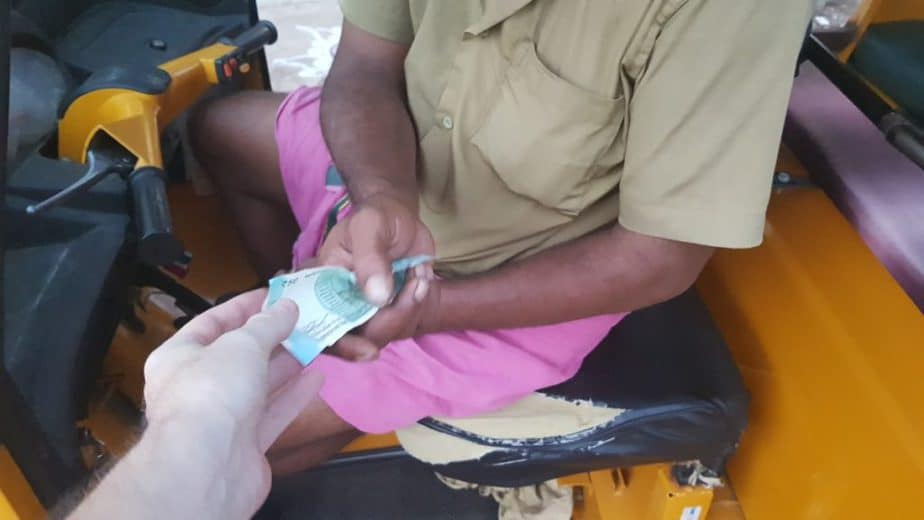
The main thing you can do to prevent being overcharged is to know the prices. The prices do vary by city but there’s a general standard price you can apply.
In Delhi, they set standard prices (which just increased by 18%) and they are:
- Metre Down Charge (First 1.5 km): 25 Rupees
- Each addition km: 9.5 rupees
- Waiting charge (ex. stoplights, if you go into a store): 0.75 rupees per minute
- Luggage charge: 7.5 rupees
***The prices are 25% to 50% extra between 11 pm and 5 am.
For example, if you’re going from the New Delhi Railway Station (Paharganj) to the Khan Market this is a distance of 6.2 km. Therefore the total cost should be ~65 rupees.
However, in reality, you may have a hard time finding this price.
If you can get between 10 to 20 rupees of this price, so 75 or 85 rupees would be a common price.
Before I show you a script, use these tools to estimate the price…
TIP #1: Use Modern Tools like Google Maps, Uber and Ola
Google Maps will estimate your taxi price now, and can even connect you to Uber and Ola which also have an option for auto-rickshaws.
The prices are reasonable as well.
Using Google Maps to estimate, a trip from New Delhi Railway Station (Paharganj) to Khan Market would cost:
- Auto Rickshaw: 71-85 rupees
- Ola: 83 – 100 rupees
- Uber: Not available
Read more: A Big List of the Best Travel Apps for India
The Most Simple Way to Get a Fair Price for a Rickshaw
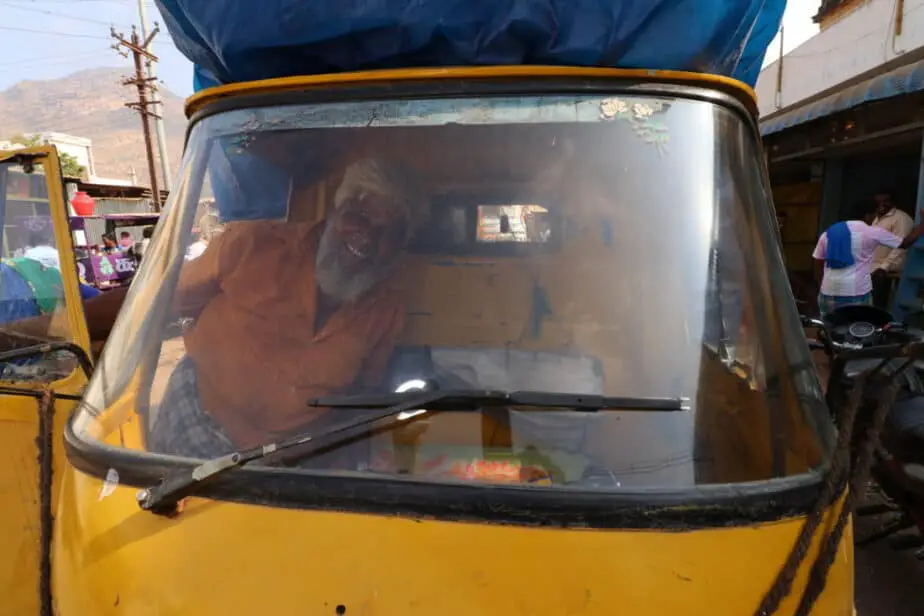
There is a simple way you can get a fair price for a rickshaw that does NOT require ANY negotiation. Here’s what to do:
Figure out the Price of a Rickshaw Ride to Your Destination
- Use Google Maps
- Ask your hotel concierge
- Ask a local
- Estimate using the Delhi prices above
Once you have the estimated price, just walk up to a rickshaw and ask them,
“Will you take me to [DESTINATION] for [FAIR PRICE]?”
-You
By confidently starting with the price you want, this lets them know you’re not a clueless tourist and you will have a good chance of getting your price.
Or at least start the negotiation on your terms.
If that doesn’t work, or you want to try to get a better price, try this script…
This post is a part of my series on Getting Around India with transport tips. Check out my full post for more on Indian airports, trains, buses, and even elephants.
A Simple Script to Getting A Fair Price for a Rickshaw in India
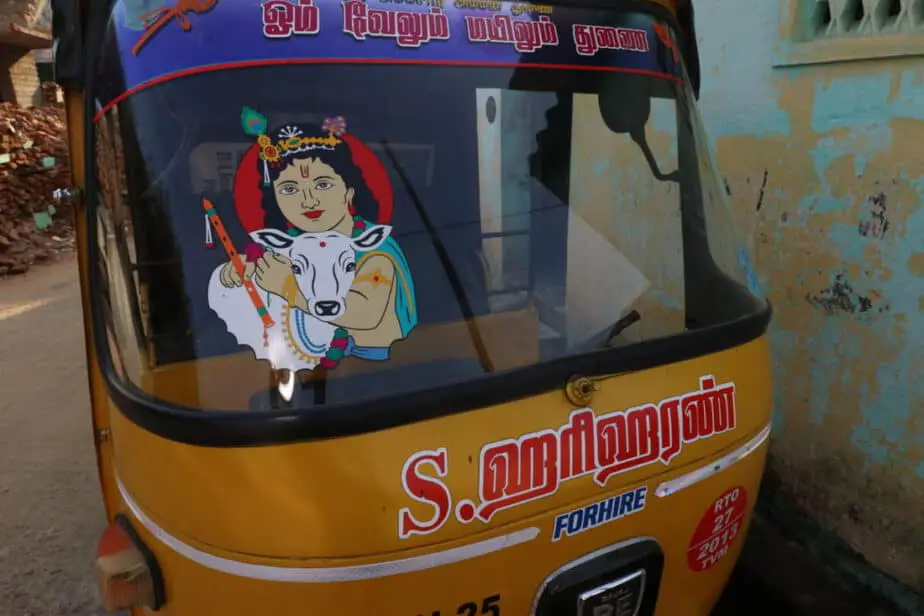
Disclaimer: I will admit that I’m not exactly a cold-blooded business negotiator. If you’re looking to get the very best price on a rickshaw this probably won’t get you that. But it will get you a fair price without too much trouble.
The constant negotiations in India can tire me out, so I came up with a simple script I can follow, even when I’m tired, to get a decent price.
The reality is: The rickshaw driver has a distinct advantage in the negotiations. They’ve been doing this most of their life probably AND more importantly, they have more skin in the game. That extra 20 or 50 rupees could mean more to them than it does to you.
Therefore, I’m okay to admit defeat a bit and not get the very best price.
I just do NOT want to get totally ripped off. But if I get with 25 to 50 cents of a great price, then I’m happy.
Here’s the Script I Use:
Me: “How much to the [DESTINATION]?” I show them on my phone.
Me: “It will be [NUMBER of KMs].”
DRIVER: “Yes, get in.”
ME: “How much to the [DESTINATION]? It will be [NUMBER of KMs].”
DRIVER: “[HIGH PRICE]” They might ask me to get in again and we repeat the process or they quote a high price…
ME: “[25% of their HIGH PRICE]” I counter with 25% of whatever price they started with.
DRIVER: “No no”
ME: “[~5 – 10 rupees more]” I quickly come up a little to show them, I want to negotiate.
If the driver comes down a little bit, then I know he is willing to negotiate. If he does NOT come down, then I say thank you and walk away to try again with someone else.
DRIVER: “[HIS PRICE COMES DOWN]”
ME: “[MY PRICE GOES UP].”
We continue until…
ME: “[50% of HIS FIRST OFFER] Final price.” I offer 50% and state final price.
DRIVER: “No no, [HIS PRICE THAT’S HIGHER THAN 50%].” He won’t go for 50%.
ME: “[50% PRICE]. Final price.” I stand firm on price.
DRIVER: “No no, [HIS HIGHER PRICE].” He stands firm on price.
ME: “Okay, thank you.” Then I walk away.
DRIVER: “Okay, [60% of HIS FIRST OFFER].” As soon as you start to walk away they usually blurt out a lower price. Not 50% but usually it’s like 60%.
ME: “Sounds good.”
Usually, we both laugh and smile and off we go. Feeling like we both won, haha.
I can rarely get to 50% of their initial offer if I do it’s like my super lucky day.
If I can get them within 10 to 20 rupees of 50%, then I’m happy. We’re only talking about 15 to 29 cents.
The Basic Things I Always Do in a Negotiation:
- Start at 25% of their high price
- Quickly raise my price, when they say “No No.” It’s the signal you want to negotiate.
- If they don’t come down a little, I walk. They’re going to be too tough for my blood.
- We both evenly give on price.
- When I get within 10 – 20 rupees of the price I want, I say this is my final price.
- If they don’t agree, then I walk.
- Walking away will usually bring them down 10 to 20 rupees. If it does not, then I find someone else and repeat the process.
- Then I agree to a price a little higher than my ‘final price’, so they feel like they won.
Then off we go 🙂
If you’re like me and want to have a simple process, you can follow every time, this could work for you every time and make sure you get a decent price.
Read more: Indian Airport Travel Tips & Hacks
Tips to Getting Fair Prices on Rickshaws in India
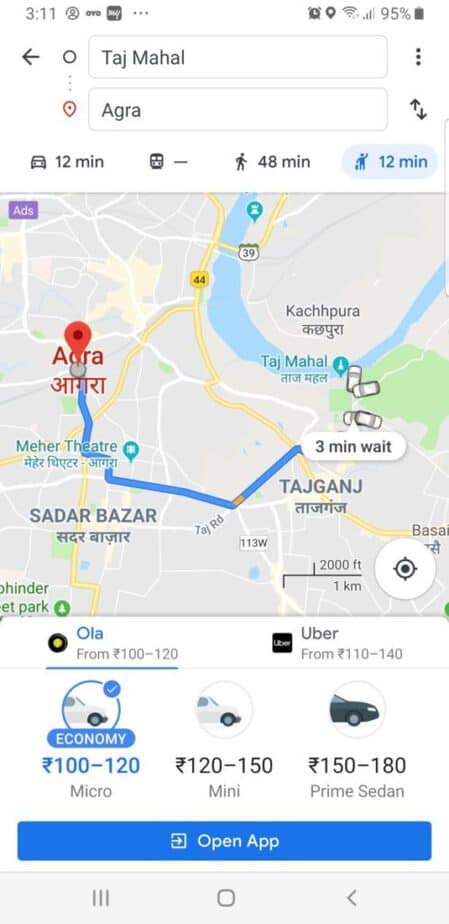
Tip #2) Use Uber and Ola
Uber is in ~40 cities in India now. Ola was the Uber of India before Uber arrived.
The benefit of using Uber or Ola is that there is no haggling. You will be quoted a price and that is the set price.
The prices are within reason, maybe 20 – 50 rupees higher than you can negotiate yourself.
Do NOT assume these drivers have been thoroughly verified as they might be in the USA though. You still want to take precautions. You also might deal with a driver who wants to charge you extra for this or that.
Another benefit of these services is that you have a formal method to complain and report the driver.
Here’s a full article on how to use Uber in India.
Tip #3) Explain the Destination

One challenge you’ll quickly run into is that the rickshaw drivers don’t speak English. Therefore when you say your destination, you may not pronounce it in a way that they can understand.
They also will NOT instantly understand if you show them on Google Maps.
Here are some strategies to clearly convey where you want to go, so the driver understands:
- Ask a local. If there is a hotel doorman, a security guard, or a policeman nearby these are best. Someone who is ‘working’ is ideal. Often they won’t mind helping you and when they explain it in the local language you can be pretty sure you’re heading in the right direction.
- Google Translate. If that doesn’t work, try Google Translate. I take a screenshot of the route where the destination is clearly visible. Then I add the screenshot to Google Translate, click on the destination, and it translates it for me into Tamil (the local language where I live). This does NOT work 100% of the time, but is a good back-up and works well in combination with slowly pronouncing and using Google Maps AND lots of patience 🙂
Tip $4) Agree to a Price BEFORE You Get Inside
I’ve always found that the driver just wants me to get in and go. Every time I take a rickshaw, I need to repeat the question, “What is the price?” or “I will pay 50 rupees, yes?”
If you try to negotiate after the ride you have lost all leverage, because you can’t walk away. Therefore, you will need to pay his price or risk getting in an argument with him.
Tip #5) 150 Rupee Rule
In general, you should never pay more than 150 rupees for a rickshaw.
If you are quoted a higher price, use my script to talk him down.
Or consider getting another form of transport, like a taxi or Uber or Ola cab.
Rickshaws are a lot of fun, however, they are also exposed to the dust and pollution. You’ll also be right there in the street with the people and the buses and cars. For the sake of your back at least, consider another form of transport.
Tip #6) Use Prepaid Auto Rickshaw Stands
There are prepaid taxi and auto-rickshaw counters at airports and major train stations in many of Indians major cities and tourist destinations.
For example, at the New Delhi Railway Station you can find one.
At these stands, you just tell the clerk where you want to go and you pay in advance. He will ask if you have luggage, which is an extra 10 rupee charge for each large bag.
Then you will get a receipt and you may stand in line to get a rickshaw or taxi. Or the driver may take you to his rickshaw.
Major airports and train stations will have aggressive drivers outside looking to get a high rate from an unsuspecting tourist (not you!), so just ignore the drivers that approach you.
They will NOT give you a better rate than the prepaid rate (or else wouldn’t they just wait?)
Once you arrive at your destination, pay the clerk the price that is quoted. Do NOT pay more. They may try for more.
The driver may say you gave an inaccurate destination and he had to driver farther, yada yada, but this is just a common ploy.
Pay what you owe and move along.
Tip #7) Choose a Passing Rickshaw
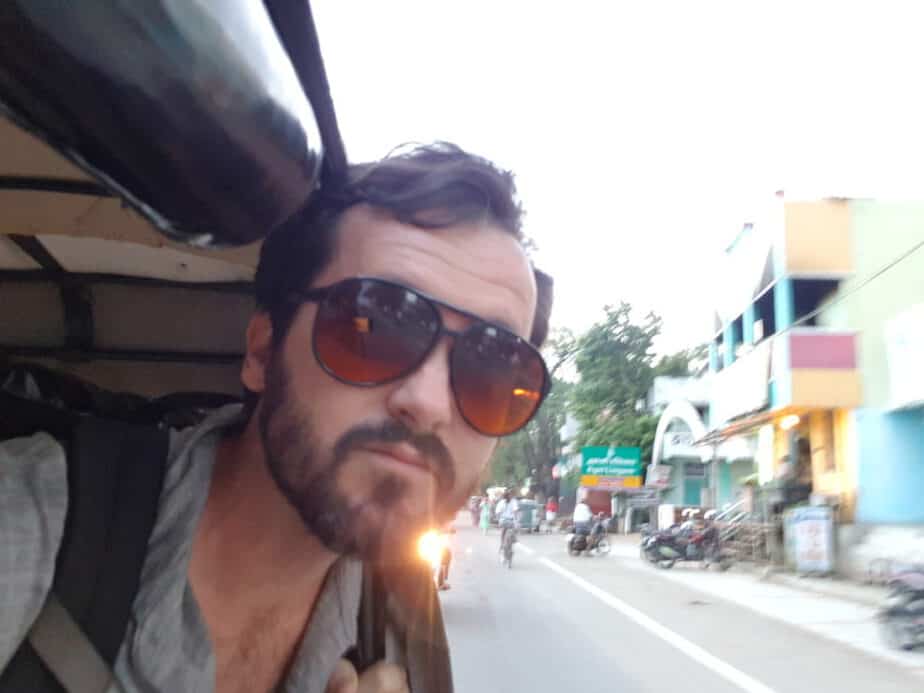
Some travelers have found you can get a better rate from a rickshaw driving by, than one that is sitting around waiting.
The hypothesis is that the waiting driver might inflate his fee to account for the time he was waiting.
Tip #8) Find a Group of Not Busy Rickshaws
Other travelers have found that if you approach a group of rickshaws who are waiting, you can use the competition to your advantage to negotiate a better rate.
Tip #9) Ask Them to Start the Meter
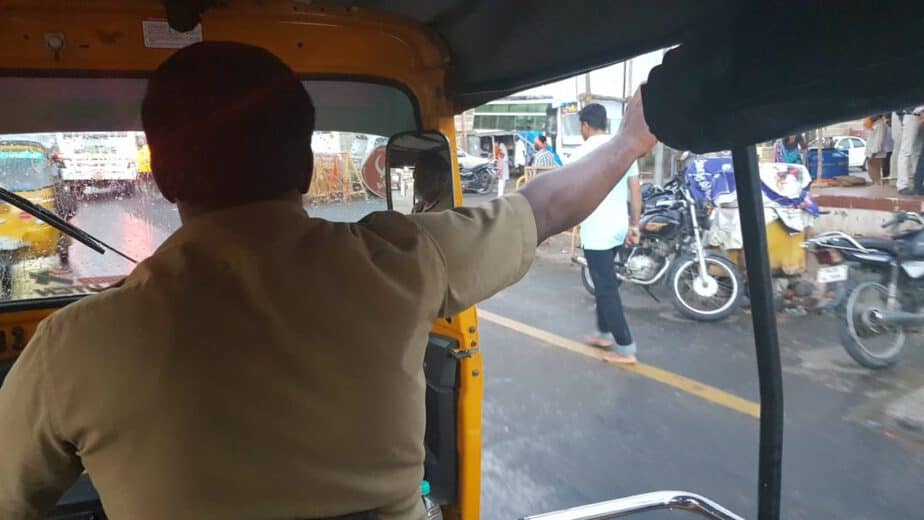
Most rickshaws I have been in do NOT have meters. If they do have a meter, they do NOT start it or use it.
Mumbai is the exception. It is required by law to use the meter in Mumbai.
One thing you want to do is ask them to start the meter, as the ride starts. You want to avoid them saying the meter was broken, once you get to your destination. Then having to negotiate the price once you are already there.
Tip #10) Ask to See the Rate Card
Drivers in cities like Mumbai and Delhi have a rate card.
You can insist upon seeing the rate card before you negotiate prices.
The driver may say he doesn’t have a rate card OR it has been said that some drivers have a rate card they only show to tourists with inflated prices.
One tip would be to ask to see their rate card in front of your hotel doorman and ask the driver to agree to follow the rate card.
In Chennai and the town I live in Tamil Nadu, they do NOT have rate cards though. You might find the same if you are not in Delhi or Mumbai.
Tip #11) Get a Round Trip Price
The waiting charge is less than 1 rupee per minute in Delhi.
In Chennai, you might just slip the driver 20 rupees for waiting for you for 30 minutes.
As you will see there are a lot of rickshaw drivers, so it may be worth it for a driver to wait for you for a couple of hours to have a guaranteed fare.
It also may be worth it for you to get a good driver, or not have to find another rickshaw or negotiate another price.
Tip #12) Consider Your City
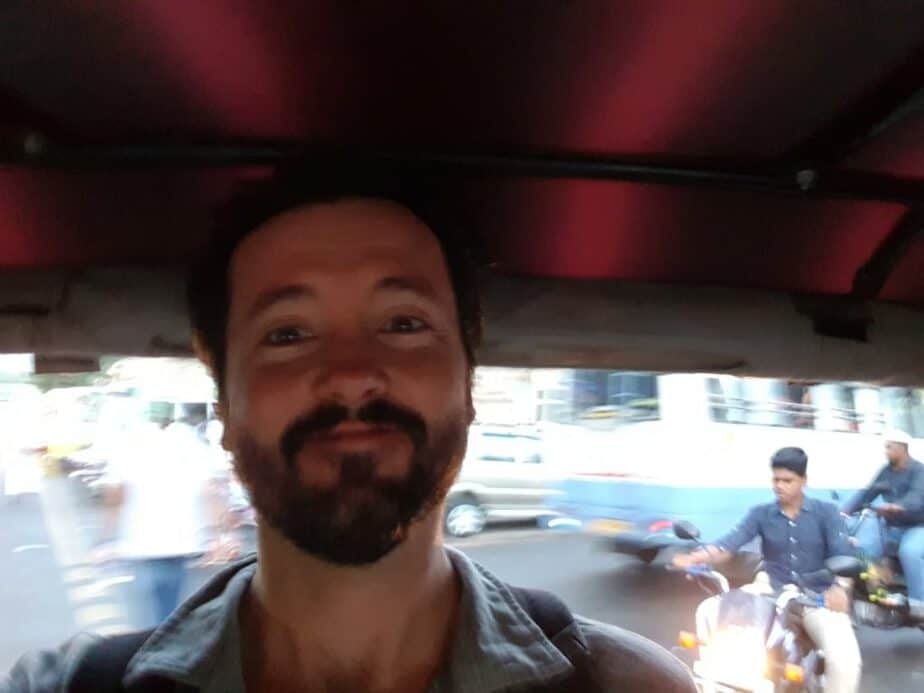
Mumbai’s rickshaw and taxi services are well-regulated. Delhi is less regulated and the rickshaw drivers can be more aggressive in their negotiations.
In Goa, the taxi and rickshaws have such a monopoly on transport and such power in the local government, you will pay much higher prices.
In Goa, they won’t even allow Uber or Ola to help drive the prices down.
Therefore, you may find the prices in your destination to be similar. If you apply the script though, start at 25%, then slowly move up, walking away if you have to, then you can get a fair price for the area.
Tip #13) Tipping
“Fare is fair.” The taxi drivers sometimes say this, and they are NOT expecting a tip.
If the fare works out to be 65 rupees, then it would be generous to give 70 rupees and say “Keep the change.”
If the driver takes you on multiple trips over a couple of hours and he did a good job, then it would be generous to give him a 10% tip.
For most short single trips, it is not necessary to tip. If you do the driver may even look confused, like do I need to give change? Does this person not know basic math? What is this?
Tip #14) Choose Your Location Wisely
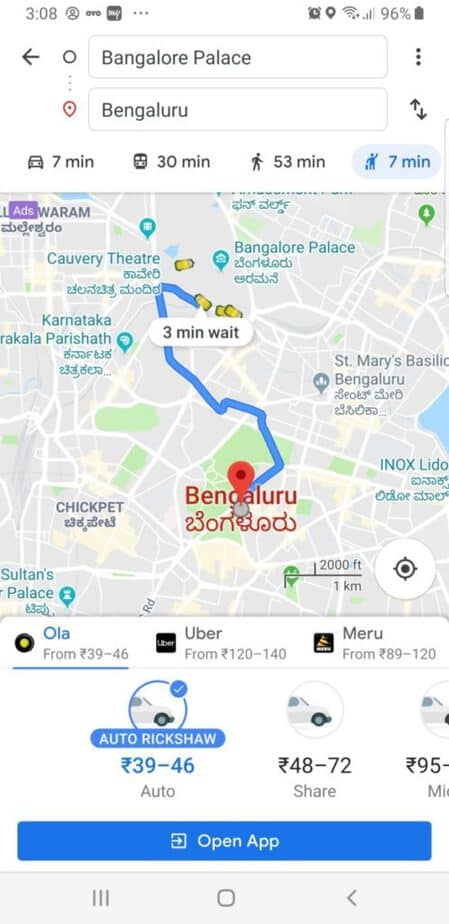
Where you hail your taxi and where you get out will affect the price you can get.
You’ll pay more if you are:
- Outside of an expensive hotel
- Near a major train station
- Near an airport
- Near a popular tourist destination
Just walk 200 to 300 meters away from these places along a busy road (so there is competition), and hail a passing rickshaw.
On your way back to your expensive hotel, know a popular intersection that is close to your hotel. Tell the driver that location instead of your hotel, and you will be able to negotiate a better rate.
Tip #15) Should You Share a Ride?
In general, no.
Rickshaws are so inexpensive it is better to just get one for yourself or you and your friends.
It is assumed if you negotiate a price, then it is just for you and if the driver does pull over to let someone else in then that would violate your deal and you can get out. Or negotiate a lower price.
In some areas of Mumbai, Jogeshwari, and Kandivali, you will find drivers who do operate shared rickshaws that take up to 3 people (the most a rickshaw can legally take, but you will see some packed to the gills).
These rickshaws can be very inexpensive and may work for you if you use them often and trust the drivers.
Read more: All The Tourist Scams in India & How To Protect Yourself
Related Questions:
Are Auto-Rickshaws Safe?
In my experience, yes.
These guys can be crazy drivers, but they seem extremely good at fitting that rickshaw into the narrowest of crevices in traffic.
In big cities like Delhi, you will want to protect your throat and lungs though by wearing an air mask as the pollution can be brutal.
I do NOT recommend them for anything more than short trips since the traffic can be bad. If you are waiting in the pollution, that is not healthy for your lungs.
What is the Tuk-Tuk Price in India per km?
9.5 rupees per km. 25 rupees for the first 1.5 km. Often you will pay more though.
It varies by city though. I can’t get a driver below 50 rupees for a 2 km trip.
Use the script above to get a fair price and have fun 🙂

